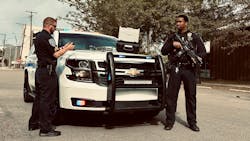Reliable Devices: Managing Tech to Keep Officers Safe
Officers on the street must have the technology and devices they need to get the job done. When those devices fail, it’s the job of IT technicians to work through those issues so that officers can continue to efficiently and effectively perform their duties on and off the road.
This article appeared in the July/August issue of OFFICER Magazine. Click Here to subscribe to OFFICER Magazine.
Meeting the needs of law enforcement officers is especially critical for small agencies like the Slidell Police Department in Louisiana, which recently added the TOUGHBOOK 55 laptop from Panasonic Connect to its solution lineup to meet officer and IT team needs. The TOUGHBOOK 55 offers a dependable, customized solution officers can use in the office, on the road or out in the field.
Mark Collins, Operations & System Manager, and Mason Foltz, Technology Support Specialist, from the Slidell Police Department recently answered some questions for OFFICER Magazine about how new and updated technology can help alleviate some of the issues faced by officers and IT teams.
What challenges has the Slidell Police Department faced in the past when it comes to managing devices and IT issues?
We are a small IT team, so having reliable devices and software solutions is critical for us. We’ve found in the past that having numerous SKUs and form factor devices adds complexity from a troubleshooting and servicing standpoint. Deploying one standardized rugged device across our department has been important for efficiency and helps our IT team dramatically. Additionally, we made a conscious effort to streamline troubleshooting and services. We did this by working closely with the team at Panasonic Connect, who we see as an extension of our IT team. By outsourcing or directly connecting our workforce with Panasonic’s ProServices Group for troubleshooting and servicing needs, we keep devices in rotation, officers on the job, and the employee experience positive.
It’s our philosophy that we should empower officers with the technical knowledge necessary to independently operate devices effectively and efficiently. Overall, the reliability and ease-of-use of the TOUGHBOOK 55 helps our department embrace this philosophy.
How have advances in technology helped alleviate some of these challenges?
There have been a number of ways, whether talking about the capabilities of devices, or the way they are utilized, or even how they are serviced. In the public sector, advancements and innovations in technology look a little bit different to those in other industries. Everything is specifically built for a purpose. In mission-critical situations, it has to be. From a device perspective, the modularity of the TOUGHBOOK brings an enterprise-like user experience to a rugged device. We have the flexibility to change out ports and device functionality post-purchase, switching out authentication readers and adding external features like DVD players, without having to deploy an entirely new device. These modular components, on top of many other innovations such as colored backlit keyboards, screens with glove-touch and rain-sensing technology, and hot-swappable batteries that extend device usage, all support the remote officer. This flexibility extends to the full ecosystem of technology that accompanies the TOUGHBOOK. It allows us to build a full mobile workstation for our officers. For example, advancements in customizable docking keep vibrations in-vehicle to a minimum and devices secure. Meanwhile, our IT team can leverage Panasonic Smart Services, a suite of solutions to monitor battery life and device performance, giving us the ability to predict the need for troubleshooting before it results in downtime.
How has the TOUGHBOOK 55 made the jobs of officers on the street and the IT team easier?
The TOUGHBOOK 55 gives our officers and our IT team the flexibility we need. The ability to house advanced computing power and connectivity in a device without sacrificing reliability and durability makes all the difference. It means that officers are equipped with the solutions they need today, while also allowing us to capitalize on emerging technologies as they proliferate our industry. The ability to gather, process and share data and critical information with speed results in greater situational awareness for officers in the field.
We have a vehicle dock for officers out in the field, a desktop dock for employees who spend the majority of their time in the office, and a kiosk with vehicle docks in the office for staff who come and go between the office and patrol car. The TOUGHBOOK 55 offers our IT team stability while giving our workforce versatility, supporting multiple groups within our department from animal control, training, patrol, and CIV to the motorcycle group, CSI and records, correction, and the executive branch.
From an IT perspective, trouble requests have dropped by two-thirds since deploying the TOUGHBOOK 55. And if troubleshooting is needed, we can easily call Panasonic Connect’s support team to fix it over the phone or send it out for a quick repair. Since deploying the device, our IT team has experienced greater efficiency and has been able to minimize the money and time spent servicing units. With fewer device issues and less time spent on repairs, our officers enjoy greater productivity and can spend more time building relationships in the community.
What advantages has the modularity of the device given officers and the department?
The modularity of the TOUGHBOOK 55 allows the department to future-proof our technology investments for years to come. After we had purchased the units, some officers came to us needing the capability view evidence DVDs. Instead of having to purchase entirely new devices for them, we were able to add DVD players to the relevant units. Additionally, our IT team appreciates that we can easily remove and replace components ourselves with the device’s user-removable expansion packs (xPAKs) instead of having to ship the units back to the manufacturer for updates. This way, our IT team still benefits from everyone using the same model, but officers enjoy the flexibility of using a device catered to their specific needs.
How has the mobility of the devices allowed officers to take their work with them wherever they go?
The mobility and reliability of the TOUGHBOOK 55 have given officers more flexibility to freely move between the office and patrol car. Instead of having to wait until the end of their shift to return to the office and file a report, they can file it from their vehicle-docked device while the incident is still fresh in their memory. Varied connectivity options mean officers can access critical information, relay important information to peers and central command, and even join meetings virtually. Now, officers can stay where they are needed most in the field in case an emergency arises. This level of flexibility is key in our unpredictable industry. For example, the device’s combined connectivity and ruggedness helped our department continue operations during Hurricane Ida.
In what way does the TOUGHBOOK 55, along with advances in other devices, help keep officers on the street more aware of their surroundings?
The connectivity and portability of the TOUGHBOOK 55, coupled with advances in accompanying software, ensure officers have access to data and the ability to share it with their peers in real-time. This allows officers to collaborate more efficiently with other first responders who may have already arrived at the scene.
From a usability perspective, there are a number of key features that ensure officers stay active and connected in any type of environment. For example, officers can change the color of their backlit keyboards for the best visibility at night and during the day. Meanwhile, the range with which an officer can either dim or brighten the screen affords flexibility. If trying to stay covert at night, officers can dim the screen can to the point where it’s undetectable to those passing by. Meanwhile, in harsh sunlight, the brightness can reach extreme levels for maximum viewability. Lastly, the device’s ability to dissipate heat and support an extended battery life means it can be docked in a vehicle and taken remote at a moment’s notice. This way, officers can tap into data systems and receive critical visual information from drones and other vehicles that assist with coordinated response efforts, boosting their overall situational awareness.
This article appeared in the July/August issue of OFFICER Magazine.
About the Author
Paul Peluso
Editor
Paul Peluso is the Managing Editor of OFFICER Magazine and has been with the Officer Media Group since 2006. He began as an Associate Editor, writing and editing content for Officer.com. Previously, Paul worked as a reporter for several newspapers in the suburbs of Baltimore, MD.

